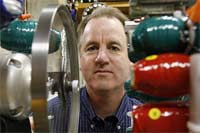Thane Heins is nervous and hopeful. It's Jan. 24, a Thursday afternoon, and in four days the Ottawa-area native will travel to Boston where he'll demonstrate an invention that appears – though he doesn't dare say it – to operate as a perpetual motion machine.
The audience, esteemed Massachusetts Institute of Technology professor Markus Zahn, could either deflate Heins' heretical claims or add momentum to a 20-year obsession that has broken up his marriage and lost him custody of his two young daughters.
Zahn is a leading expert on electromagnetic and electronic systems. In a rare move for any reputable academic, he has agreed to give Heins' creation an open-minded look rather than greet it with outright dismissal.
It's a pivotal moment. The invention, at its very least, could moderately improve the efficiency of induction motors, used in everything from electric cars to ceiling fans. At best it means a way of tapping the mysterious powers of electromagnetic fields to produce more work out of less effort, seemingly creating electricity from nothing.
Such an unbelievable invention would challenge the laws of physics, a no-no in the rigid world of serious science. Imagine a battery system in an all-electric car that can be recharged almost exclusively by braking and accelerating, or what Heins calls "regenerative acceleration."
No charging from the grid. No assistance from gasoline. No cost of fuelling up. No way, say the skeptics.
"It sounds too good to be true," concedes Heins, who formed a company in 2005 called Potential Difference Inc. to develop and market his invention. "We get dismissed pretty quickly sometimes."
The creation in question is a new kind of generator called the Perepiteia (read related story "Holy crap, this is really scary"), which in Greek theatre means an action that has the opposite effect of what its doer intended. Heins torques up the definition to mean "a sudden reversal of fortune that's a windfall for humanity."
Today, Heins is focused on showing his invention to anybody willing to see it, in hopes that somebody smarter than him will give it credibility. His long-time friend, Kim Cunningham, manager of communications and government relations at the Ottawa Centre for Research and Innovation (OCRI) is working part-time with Potential Difference to help get the message out.
Together, they have demonstrated the Perepiteia to a number of labs and universities across North America, including the University of Virginia, Michigan State University, the University of Toronto and Queen's University.
"It's generally always the same reaction," says Heins. "There's a bit of a scramble on the part of the observer to put what they're seeing into some sort of context with what they know. They can't explain it. They don't know what it is."

